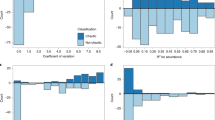Abstract
Ordered categorical (or semi-quantitative) data are frequently encountered in ecology (e.g., Steen et al. 1990; Ménard et al. 1993). Researchers often resort to semi-quantitative measures (to describe abundance patterns, age or stage structures, environmental factors, etc.) to reduce processing time and/or because of financial constraints, while retaining an acceptable level of accuracy.
Access this chapter
Tax calculation will be finalised at checkout
Purchases are for personal use only
Preview
Unable to display preview. Download preview PDF.
Similar content being viewed by others
References
Burkey, T. V., and N. C. Stenseth. In press. Population dynamics of a territorial species in a patchy and seasonal environment. Oikos.
Chatfield, C. 1989. The Analysis of Time Series: An Introduction. Chapman & Hall, New York.
Diggle, P. J. 1990. Time Series: A Biostatistical Introduction. Oxford Science Publications, New York.
Frontier, S. 1969. Sur une méthode d’analyse faunistique rapide du zooplancton. Journal of Experimental Marine Biology and Ecology 3:18–26.
Kedem, B. 1980. Binary Time Series. Lecture Notes in Pure and Applied Mathematics, Vol. 52. Marcel Dekker, New York.
Kullback, S. 1959. Information Theory and Statistics. Wiley and Sons, New York.
Legendre, L., M. Fréchette, and P. Legendre. 1981. The contingency periodogram: A method for identifying rhythms in series of nonmetric ecological data. Journal of Ecology 69:965–979.
Legendre, L., and P. Legendre. 1979. Ecologie Numérique. 2. La Structure des Données Écologiques. Masson, Paris.
May, R. M. 1974. Biological populations with non-overlapping generations: Stable points, stable cycles, and chaos. Science 186:645–647.
Ménard F., S. Dallot, and G. Thomas. 1993. A stochastic model for ordered categorical time series. Application to planktonic abundance data. Ecological Modelling 66:101–112.
Parker, T. S., and L. O. Chua. 1987. Chaos: A tutorial for engineers. IEEE Proceedings 75(8).
Piatt, T., and K. L. Denman. 1975. Spectral analysis in ecology. Annual Review of Ecological Systems 6:189–210.
Rose, G. A., and W. C. Leggett. 1990. The importance of scale to predator-prey spatial correlations: An example of Atlantic fishes. Ecology 71:33–43.
Shugart, H. H. (ed.). 1978. Time Series and Ecological Processes. SIAM, Philadelphia.
Sprules, W. G., B. Bergström, H. Cyr, B. R. Hargreaves, S. S. Kiliam, H. J. Maclsaac, K. Matsushita, R. S. Stemberger, and R. Williams. 1992. Non-video optical instruments for studying Zooplankton distribution and abundance. Archiv für Hydrobiologie Beiheft 36:45–58.
Steen, H., N. G. Yoccoz, and R. A. Ims. 1990. Predators and small rodent cycles: An analysis of a 79-year time series of small rodent population fluctuations. Oikos 59:115–120.
Vandermeer, J. 1982a. To be rare is to be chaotic. Ecology 63:117–168.
Vandermeer, J. 1982b. On the resolution of chaos in population models. Theoretical Population Biology 22:17–27.
Weber, L. H., S. Z. El-Sayed, and I. Hampton. 1986. The variance spectra of phytoplankton, krill, and water temperature in the Antarctic Ocean south of Africa. Deep-Sea Research 33:1327–1343.
Editor information
Editors and Affiliations
Rights and permissions
Copyright information
© 1995 Springer Science+Business Media Dordrecht
About this chapter
Cite this chapter
Stockwell, J.D. et al. (1995). Detecting Periodicity in Quantitative versus Semi-Quantitative Time Series. In: Powell, T.M., Steele, J.H. (eds) Ecological Time Series. Springer, Boston, MA. https://doi.org/10.1007/978-1-4615-1769-6_8
Download citation
DOI: https://doi.org/10.1007/978-1-4615-1769-6_8
Publisher Name: Springer, Boston, MA
Print ISBN: 978-0-412-05201-9
Online ISBN: 978-1-4615-1769-6
eBook Packages: Springer Book Archive




